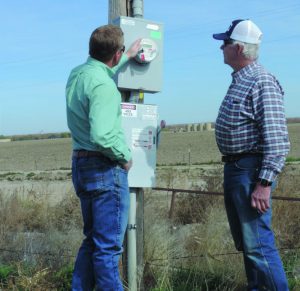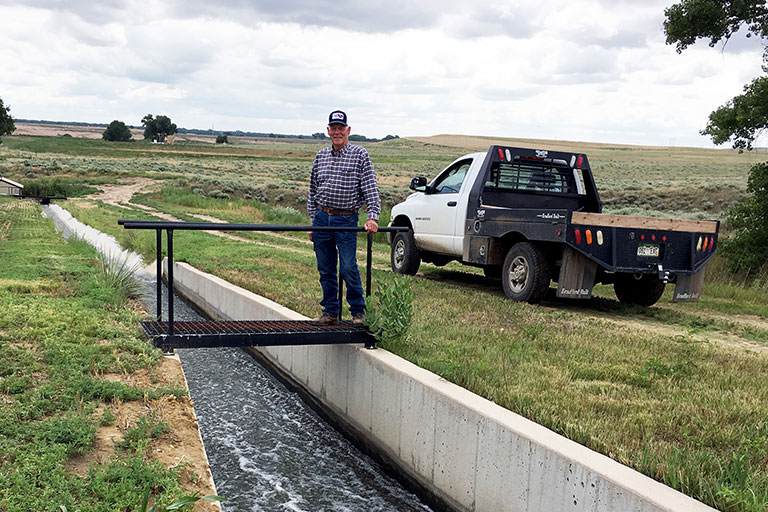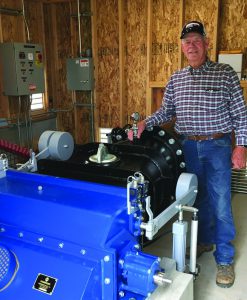By Mary Peck
Colorado’s eastern plains are probably the last place a person would expect to find a hydroelectric project installation, but that’s exactly where Poudre Valley Rural Electric Association member Jim Park’s micro hydro generator is planted — along an irrigation ditch on his farm 8 miles east of Kersey, to be precise. The 25-kilowatt generator turns out enough power to run the center pivot on his farm’s sprinkler, which waters 100 acres of corn and alfalfa throughout the growing season.
In a state renowned for pioneering hydroelectric projects of all shapes and sizes in mountainous areas, Park’s micro hydroelectric project is unique to say the least, and the only such project in the Fort Collins-based electric cooperative’s service area. “We thought it was a really interesting project to partner with,” said Tony Francone, PVREA member relations representative and energy use advisor. “We were excited to be able to help Jim and provide the interconnection for it to come back to his metering.”
As the name implies, micro hydroelectric projects are small installations, generally up to 100 kilowatts in size, according to Sam Anderson, energy specialist and program administrator with the Colorado Department of Agriculture.
Growing federal and state support for renewable energy production, particularly through the Colorado Department of Agriculture’s ACRE3 (or Advancing Colorado’s Renewable Energy and Energy Efficiency) grant program, is a big driver for increasing interest in agriculture hydropower across Colorado, which has some of the best incentives in the nation. “Since we started this program, Wyoming and Oregon have been working on developing similar programs, so it’s making an impact,” Anderson said.
Earlier this fall, Meeker-based White River Electric Association began operating its co-op’s first micro hydroelectric project. Like Park’s unit, the WREA Miller Creek Ditch Hydro Project utilizes irrigation ditch water to generate power. “The collaborative nature of the Miller Creek Ditch Hydro Project met all of WREA’s goals,” said Trina Zagar-Brown, WREA general counsel and member services manager. “It has been widely supported by our agricultural community and our membership as a whole.”
It was his own lifelong agricultural background and experience as a PVREA board member for more than two decades that helped foster Park’s interest and knowledge in ag-related hydroelectric generation. Through his own research and assistance from Fort Collins-based Community Hydropower Consulting, Park took advantage of grant programs through the Colorado Department of Agriculture, the U.S. Department of Agriculture Rural Development and the USDA’s Natural Resources Conservation Service. All three were coordinated under the Regional Conservation Partnership Program, which provides a means to stack the three sources of funding as part of its mission to promote conservation activities led by local grassroots initiatives and supported by the USDA.
“Jim was one of the first to take advantage of the program,” Anderson said. He noted that, while most of the state’s agricultural hydroelectric projects are on the Western Slope, there are plenty of potential generation sites east of the Continental Divide. “It only works well with gravitational energy, but there is a surprising amount of opportunities in Weld County and the Front Range,” he said.
Park had his eye on his farm’s hydropower site for years. Placing the turbine at the bottom of a 25-foot slope in his irrigation diversion off the Lower Latham ditch made sense in terms of water efficiency improvements. “Many times I’ve watched that thing and thought that would be interesting to put a generator on it,” Park said.

Jim Park (right) and Tony Francone from PVREA check the meter connected to the hydro power project. Photo by Mary Peck
Park’s quest led him to the Ossberger manufacturing company in Germany, where micro hydropower projects are relatively prevalent. Founded in 1873, the company’s patented flow turbine was developed to work with small water power resources. Park’s cross-flow turbine was manufactured specifically for his land elevation, water volume and generation needs. The unit took a six-week journey on a container ship to the United States before it was installed. A control panel with a trash collector screen was then set up as was a new net meter, and on June 26, 2017, the cross-flow turbine began generating power.
“My goal was about 40,000 kilowatt-hours. That’s about what my sprinkler uses and I think we’re going to reach that goal,” Park said. He estimates that he will generate around 80 percent of the power required to run his sprinkler. Should the unit generate more energy than is needed, a portion of the overage can be treated as savings in his PVREA account. This is likely since the ditch runs from April to November, before and after the actual time he needs to run his sprinkler. While he will eventually see a positive return on his investment, cost savings wasn’t the primary driver for Park. Still, it’s a nice benefit. “That’s one thing about a hydro turbine,” he said. “Once they’re in place there’s not a whole lot of upkeep. It’s expected to run 60 to 70 years.”
Park’s 260-acre farm was homesteaded by his great-grandfather in 1888 and is designated a Colorado Centennial Farm, meaning it has been owned by the same family for more than 100 years. His father was born on the farm in 1907 and Park lived on it his entire life, so it seems fitting that a historic power source, and one that makes the most of agricultural resources, found its home on the farm, too. “I’m very pleased,” Park said.
Mary Peck is a freelance writer in northern Colorado with a background in the electric co-op industry.
To learn more about irrigation hydropower and funding opportunities, an applicant navigation guide is viewable at colorado.gov/agconservation/hydro-navigation-guide. Get a quick view of the project at tinyurl.com/PVREAhydro.


